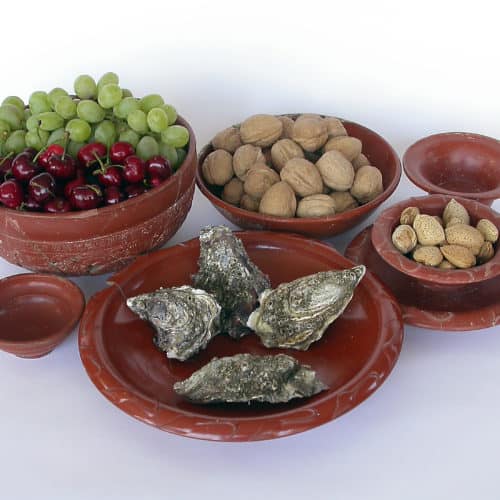Romans 10: Samian ware
This is a Roman period bowl (patera) made from a type of smooth, orange-red pottery called Samian ware.
Samian ware pottery was a luxury item. It was imported from Gaul (Roman France) and was found by archaeologists on the site of Folkestone Roman Villa.
The owner’s name was Alpinianus. The inscription ALPINIANI means "belonging to Alpianus". We don’t know much about him, except that he was probably fairly wealthy to own such a fine bowl, and that he could write. It was only the rich who were taught to read and write in Roman times.
This bowl was a multi-purpose vessel, about the same size as a modern dessert bowl. He could have eaten or drank from it.
If we turn the bowl over, there’s another name stamped on the bottom. It’s the name of the potter IVNIANVS, who made the bowl, in a place called Lezoux in central Gaul, sometime between AD 100 and 150.
He pressed his name into the damp clay, before the pot was fired in the kiln, using a wooden or metal stamp.
Samian ware was the 'must-have' luxury dining service in Roman times and most wealthy households would have used them both to serve food in or to eat from. It was probably kept for special occasions.
It came in lots of different shapes and sizes from large platters to small bowls.
Alpinianus’ patera or small bowl is plain, but lots of Samian dishes are richly decorated with scenes from Roman life.
Did you know
When archaeologists find a name scratched on an artefact they call it a graffito, which means a 'scribbling'. It’s where we get our word graffiti from!
Image copyright: Canterbury Archaeological Trust
This fragment was once part of a large, straight sided cylindrical vessel, ideal for displaying fruit as part of a Roman feast.
If you look closely you can see part of a hunting scene.
A dog is running (on the left).
It’s part of a pack, chasing a larger animal, almost certainly a deer, now largely missing, although its rear end and back leg can be seen (centre top), either side of the crack where the broken fragments have been stuck back together.
What appears to be a leaping buck, a young stag with its first stunted growth of antlers, is also visible trying to escape (centre bottom).
Why not have a go at recreating the missing parts of this design as part of a Roman art or pottery project? You could research hunting scenes from other Roman pots, mosaics or wall paintings for inspiration.
Roman gods and goddesses, gladiators, chariot races and stories from classical mythology were other popular Samian designs.
Samian ware was made by skilled Roman potters. This video shows a replica being made using the same methods:
Fascinating fact
At least two Roman cargo ships carrying Samian ware sank off the North Kent coast, probably as the result of storms. Hundreds of pots from these ships have been trawled up by local fishermen over the centuries, and many are on display at the Seaside Museum in Herne Bay.
Here is cartoon animation of their fascinating story
https://cotswoldarchaeology.co.uk/marcus-the-mystery-of-the-pudding-pans/



